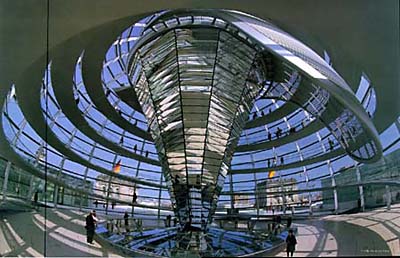| Der Deutche Bundestag | The New German Parliament, Reichstag |
Building a sustainable public structure | |

Dome inside Photo by Aoki Tsukasa |
||
|
Natural lighting and ventilation In the center of the Dome, one finds an inverted cone covered with mirrors, which were named by the architect as a "Light Sculptor". Exhaust fans are installed inside this cone, equipped with a heat exchanger system. While the cone allows natural light into the hall, it discharges the heat from the Assembly Hall below, recovering part of it by heat exchange. A brise-soleil is provided: it moves with the sun to shield off its intense, direct rays. Except for the Dome, all of the windows are of a double-skin construction, effectively shielding off the heat, while enhancing natural ventilation. Making the best use of natural energies Part of the power used to move the Dome shade and the fans is supplied by solar cells installed on the roof ( 321 m2 in size, with a maximum output of 39 kilowatts). The co-generation system, with an output of 3200kw, uses vegetable oils derived from the date palm, mustard and sunflower. Other buildings in the vicinity share the electric and thermal energies generated by the biomass, i.e., housing for the Parliamentarians, government offices and even a nursery. Good balance between energy demand and supply lead to efficiency. |
Underground vein and the building used for heat storage The massive body of the Bundestag has a tremendous heat capacity, which can be used to harness, store and recycle the heat energy on a daily basis. This helps to reduce energy consumption. There is a vein (19°C) 300 meters below the ground. A well was drilled to reach this layer to store the surplus supply of hot water at 70 degree Celsius, made by the co-generation energy nine months out of the year. The heat stored as heated water is used in the winter. The cool water made by the heat pumps driven by the stored hot water is then stored deep below the ground to be used for panel cooling of several ceilings during the summer. Achieving a 70 % reduction in carbon dioxide emission Cogeneration and heat storage technology helps reduce carbon dioxide emission by 20%, while another reduction of 50% is achieved by the use of biomass-energies. In total, carbon dioxide emissions have been slashed by as much as 70%. | |
| Previous Page | Next Page | |
|
To Index In English | ||